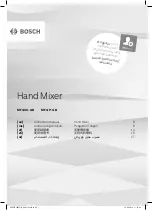
Mackie DL806 and DL1608 Reference Guide
72
FX Returns
—
There are two vertical return channel faders and
meters, one for each effect. These control the return level from
the effect to the selected output. You have seen these before,
as they are the same faders displayed in the mixer view. A pair
exists [one for reverb, one for delay] for each selected output.
Unlike the FX sends, the color of the selected output indicator
will change based on the selected output for the FX returns.
See the image to the right for one example.
Navigate to the reverb return channel, then move the channel
fader up and down. Notice that it also moves the reverb return
fader up and down. This is because they are both showing the
same level. As such, moving the return reverb fader up and
down also moves the reverb channel fader up and down.
This works with the delay return channel and delay return
fader, as well.
There are no reverb or delay returns to the reverb
and delay sends (which would be crazy...and it avoids
a feedback loop), so when either the reverb or delay
send is the selected output, there are no return faders
as seen in the image to the left.
The astute reader may ask if there are no sends from
returns and no returns from sends, what if one selects
an effect return as the current channel and an effect
send as the selected output. Good question! The image
on the left shows the FX with no sends and no returns.
Of course you may still adjust the global controls.
If you want to witness this for yourself here’s how
in two simple steps: (1) go to either the reverb channel
or delay channel and (2), select reverb or delay as the
output. Done!
Reverb Type
Reverb simulates the effect of room variations. The Master Fader app comes with nine reverb types to
choose from: plate, ambience, small room, medium room, large room, hall, cathedral, gated reverb and
spring. A button displaying the current reverb type may be tapped to reveal the other reverb types. Tap
the reverb you would like for the selected channel. The image will change to reflect the reverb type chosen.
Reverb Type
Description
Examples
Plate
Plate reverbs emulate vintage mechanical reverberation that is
generated with a metal plate. Its sound is characterized by lots
of early reflections and no pre-delay.
Perfect for thickening percussive
instruments, such as a snare drum, or
tight vocal arrangements.
Ambience
Ambience is the surrounding sound field.
This reverb adds depth and space.
Ambience is good for scoring movie
soundtracks and post-rock bands
utilizing a lot of depth in their sound.
Small Room
The small room reverb simulates the reverberation
(persistence of sound) in a typical small room. Small rooms are
typically coined “dead” rooms with little to no reverb.
Some artists record guitars (and/
or bass) from a bathroom to get a
“punchier” sound out of their amp.
Medium Room
The medium room reverb simulates the reverberation
(persistence of sound) in a typical medium room.
A medium room would be good
for thickening up a bass sound
without it sounding muddy.
Large Room
The large room reverb simulates the reverberation
(persistence of sound) in a typical large room. Large rooms are
typically coined “live” rooms since they have a lot of reverb.
Sound tends to carry in large rooms
with a lot of open space. This works
well for a good, boomy kick sound.
Hall
This reverb is characterized by its large, spacious
sound, long pre delay and vibrant tone.
Adds life to acoustic instruments
and vocals from solos to full-on
symphonies and choirs.
Cathedral
This reverb emulates the extremely long tails, dense diffusion
and long pre-delays and reflections that would be found in a
very large, stone-walled house of worship.
Gives amazing depth to choirs,
wind instruments, organs and
soft acoustic guitars.
Gated Reverb
Gated reverbs incorporate an age-old trick whereby an
extremely dense reverb is processed through a fast gate for an
interesting, albeit artificial, sound.
Most often used to fatten snare
drums and toms without clutter.
Spring
A spring reverb uses a transducer at one end of a spring and a
pickup at the other end to create and capture vibrations in a
metal spring. The longer the spring, the longer the decay time
of the reverberation.
Spring reverbs are typically used on
guitar amplifiers or organs in a rock
band format.
LR
AUX 4
















































